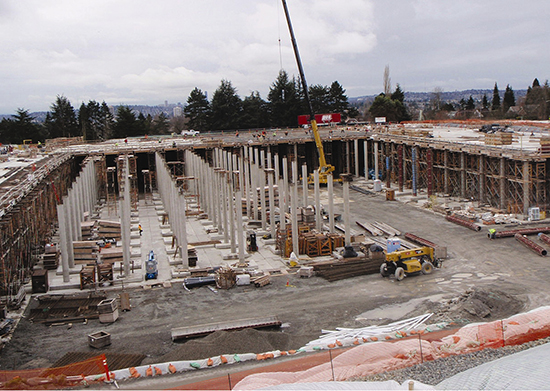|
Subscribe / Renew |
|
|
Contact Us |
|
| ► Subscribe to our Free Weekly Newsletter | |
| home | Welcome, sign in or click here to subscribe. | login |
Construction
| |
 |
May 17, 2013
Public works: Infrastructure
Maple Leaf Reservoir
Location: Seattle
Owner/developer: Seattle Public Utilities
Project team: Ferguson Construction, general and concrete contractor; MWH Americas, structural engineer; Cadman, ready-mix supplier
The Maple Leaf Reservoir is the largest of four open reservoirs to be replaced under Seattle’s reservoir-burying program.
The underground structure is a 60 million-gallon, all-concrete reservoir that’s been divided into two cells by an interior concrete wall. The separate cells allow the city to drain and clean one half while the other half is in service.
Inside the cells are 768 cast-in-place concrete columns. The surrounding concrete walls are 22 inches thick and 21 feet high.
Construction involved placing more than 31,000 cubic yards of concrete and 4,500 tons of reinforcement steel. There were around 260 individual concrete placements. A seven-day curing period was required between each of the concrete pours.
Demolition of the old reservoir generated more than 10,000 cubic yards of crushed, recycled concrete for road base.
The reinforced concrete elements composing the reservoir, slab on grade, walls, columns and elevated deck had to be placed in a way that allowed enough cure time between adjacent element. The slab on grade was placed in a checkerboard pattern, followed by the walls, columns and elevated deck.
The site also has a cast-in-place pump station and an elaborate concrete-contained bioswale system for stormwater management.
Although the reservoir was completely buried, the finish of all the concrete elements was still critical. The general contractor used its own personnel to place and finish all the concrete, allowing the contractor to fully control the process and meet stringent quality standards.
The design team applied an architectural finish to reduce unnecessary surface areas. Excess surface area allows the formation of debris and bacteria, which is undesirable in a storage facility for potable water. It also makes it harder for maintenance crews to clean.
A 16-acre park now sits atop the covered reservoir.
Other Stories:
- Shotcrete helps restore a school that went up in flames
- Concrete paving
Martin Luther King Jr. Way phase one - Special applications: Technical merit
Columbia ColStor - Special applications: Artistic merit / tie
Everett Performing Arts Plaza - Special applications: Artistic merit / tie
East Bay Public Plaza - Pervious concrete
Woods at Golden Given - Architectural/decorative concrete / tie
Lake Washington High School - Residential structures
Lions Gate - Architectural/decorative concrete / tie
St. Martin’s Abbey courtyard - Residential decorative concrete
Sprague residence - Public works: Bridges
Manette Bridge replacement - Cast-in-place structures
Seattle Cancer Care Alliance Proton Therapy - GRAND AWARD/Tilt-up structures
Everett Clinic Smokey Point Medical Center - Renton Memorial Stadium owes its good looks to concrete
- Public renovations
Percival Landing major rehabilitation



